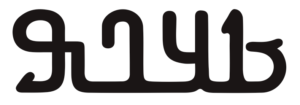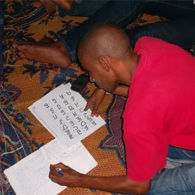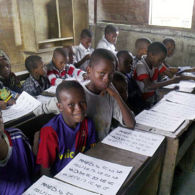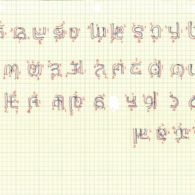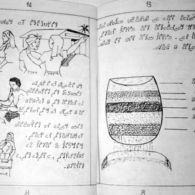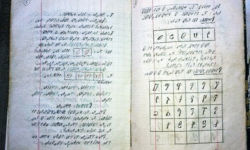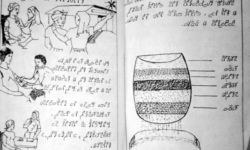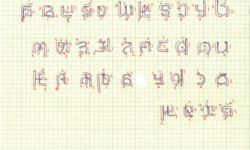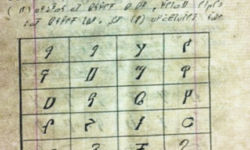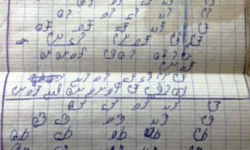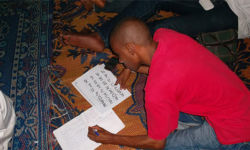Profile
Adlam is surely unique in being the only script created by two brothers, the older of whom was barely into his teens.
Abdoulaye and Ibrahima Barry grew up in a small town in Guinea, West Africa, speaking the language generally called Fulani, though in Guinea it is called Pular.
Few people in their town could read, and their father, who could, acted as a designated reader: when people received letters they took them to him in his shop in the market, and he did his best to read them.
This was more of a challenge than it might seem, as Fulani was most often written in Arabic script whose letters gave only an inconsistent approximation of the sounds of the spoken language. In 1989, Ibrahima, then fourteen, and Abdoulaye, then ten, decided they could do better.
“After school,” Abdoulaye said, “we would go in our room and just start randomly doodling. If we saw something that could be used as a letter, we would point it out.”
At the same time, they worked at the problem from the other direction: at school, if they heard or thought of a spoken sound that needed to be represented in writing, they made a note of it.
In some cases, they came up with a symbol that looked like teeth, or a bag, “so we represented that item with that letter.”
After half a year, “We told our dad we had worked out an alphabet – and he didn’t believe us.”
Their father, however, invited an expert who tested them in the same way the Cherokee National Tribal Council tested Sequoyah: by giving dictation (though in this case, he especially included words whose sounds could not be written effectively in Arabic or Latin script). One brother was told to write, then the other was told to read what had been written.
The test over, the expert declared the boys had, indeed, created a functional alphabet, of twenty-seven letters – and their father made up for his earlier skepticism by teaching the script in his shop at the market.
The first iteration was cursive, but people found it hard to discern the individual letters, so in their second iteration, the brothers separated the letters.
When Ibrahima left to study at the University of Conakry, he took the script with him, and it began to be used in classes. To provide content, they wrote books of practical advice – how to conduct a healthy pregnancy, how to filter water to make it drinkable – and a newspaper.
“All the books were written by hand,” Abdoulaye explained, because there were no typefaces or digital fonts. If they made a single mistake, they had to start writing the page again, aware that everything they wrote was, in effect, creating a linguistic standard that would be followed and thus needed to be accurate and consistent.
By 2007, both brothers had moved to the United States, and were looking for skilled help to create fonts and keyboard software. By 2016, the script had been accepted by Unicode; by 2018, Google had created a Noto Sans Adlam font and a keyboard for Android phones.
Perhaps most remarkably, the Barry brothers had effected substantial change in their own country and as many as twenty-three other countries in a west–east band across West and Central Africa where Fulani is spoken. (The Adlam script is also being adapted for neighboring languages, such as Hausa.)
”It’s about improving literacy rates generally,” Ibrahima explained. Now that people had the chance of an education in their own language, more were learning to read and write. “The people who were most excited were the women,” he went on. It is customary in Muslim communities to educate boys more than girls, so Adlam made education and literacy significantly more accessible and attainable.
As this atlas comes into being, Adlam, like Vai and N’Ko and perhaps Mandombe, is a growing new script rather than an endangered old one, and it may be moving from an indigenous minority script to a thriving regional writing system. The purpose of the atlas, though, is not to document by categories, but to play a part in the revival of minority cultures through their writing systems, and we include Adlam here as a tale of what has been done, how it has been done and what may be done again elsewhere.
The name Adlam, by the way, is an acrostic of the first four letters of the alphabet (A, D, L, M) which represent the phrase Alkule Dandaydhe Leñol Mulugol: “the alphabet which protects the people from vanishing.”
–Edited and updated by Eddie Tolmie.
It’s worth noting that before the eventual success of Adlam, other script creators had devised original ways of writing the Fula languages but were unable to get their work adopted and promoted.
Fula Dita was invented by Oumar Dembele between 1958 and 1966 in Mali. Dembele attempted to get Mali officials to officially adopt his alphabet but was forbidden to promote it, and as far as we know, he was the only person to have used it.
Around the same time, Adama Ba from Mali created a script known as Fula Ba, which he used to write his own poetry as well as for correspondence, so presumably at least a few others were able to read it. Once again, it was never officially propagated.
There is an academic tradition of calling such endeavors “failed” scripts. But there is nothing to suggest that the script itself would not have served its purpose; the failure seems more to be a matter of whether the language community and its government recognized the value of an indigenously-created unique script—a matter of time and place, perhaps.
In this sense, an emerging alphabet is almost by definition an endangered alphabet, in the sense that a fledgling bird is in danger from a host of threats until it is able to take wing, and take care of itself.
You can help support our research, education and advocacy work. Please consider making a donation today.
